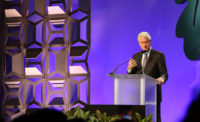In a 53 to 32 vote on November 30, the Helsinki City Council rejected a proposal to build Paris-based Moreau Kusunoki Architectes’ design for a new Guggenheim satellite museum on the Finnish capital’s waterfront. The city council’s decision is the culmination of five years of fierce dispute, which has rattled Finnish politics and sparked debate within the architecture community.
Johanna Lemola, a spokeswoman for the Helsinki municipal government said the crucial meeting was “highly emotional.” Those in favor of the project, mainly from the political right, argued that the museum would increase employment and boost tourism as the Guggenheim’s Frank Gehry-designed satellite did for Bilbao. The political left and the populist Finns Party, meanwhile, objected to the use of public money to partially fund the $138 million museum. The meeting was so tense, according to Lemola, that it was even suggested that some councilors did not attend out of fear for their safety.
The controversy began in 2011, when the city of Helsinki commissioned the Guggenheim Foundation to complete a feasibility study to explore the museum’s potential on a city-owned site along the South Harbor. The city board, the governing body below the city council, rejected the resulting proposal, which required that public funds cover a $30 million licensing fee to use the Guggenheim name.
Undeterred, the Foundation put forth a revised proposition in 2014, which stipulated that the Guggenheim would organize a two-phase, international design competition and solicit the $30 million licensing fee from private donations.
In 2015, a jury selected Moreau Kusunoki’s proposal from a pool of more than 1,700 entries, calling the design, which proposed a collection of nine interconnected charred wood volumes, “deeply respectful of the site and setting.”
But the project hit another roadblock in September, when the euroskeptic Finns Party announced that public money would not be used to finance it. In response to the veto, yet another proposal was put forth by the Guggenheim Helsinki Supporting Foundation in cooperation with the City, in which the museum’s operation would be funded entirely by private money and a loan. It still suggested that the city would finance more than half of the construction costs in addition to building maintenance.
The project’s turbulent history reflects the Finnish people’s deeply divided opinion on the virtue of injecting a global franchise into Helsinki’s cultural scene with taxpayers’ money, especially at a time when the government has imposed significant austerity measures. Other trepidations have come from the project’s perceived lack of transparency, its prime waterfront site, and the belief that the local art scene is robust enough as is.
Despite the skepticism, Ari Lahti, a Finnish businessman and the chairman of the Guggenheim Helsinki Supporting Foundation, suggested that the city council’s ruling did not represent public opinion.
“Based on a survey conducted just a week before vote, the museum would have been supported by the majority of the citizens,” he said in an e-mail. “If the government would have been formulated differently, or had the Finn’s party not been struggling to keep their voters satisfied during the beginning of their governmental term, we could have seen a different outcome.”
Guggenheim Foundation director Richard Armstrong could not be reached for comment, but speaking with the New York Times, he said, “I suppose that it was a reaction to a sense of engulfing internationalism, or a reaction against globalism."
Within the architecture community, criticism of the museum tended to be in response to the corporatization of architecture and the expanding influence of institutions.
“I find the concept of the imperial museum to be quite galling,” says critic Michael Sorkin, who heads up the architecture nonprofit Terreform. The organization, along with Finnish organization Checkpoint Helsinki and the Gulf Labor Artist Coalition, launched the Next Helsinki competition in 2014 to solicit alternative design ideas for the South Harbor site. The contest drew more than 200 entries. As follow-up to the competition, Sorkin and others will release The Helsinki Effect: Public Alternatives to the Guggenheim Model of Culture-Driven Development this month, which will include a catalogue of the competition entries, as well as essays by urbanists, artists, and architects.
“I share the idea that a highly egalitarian social democracy should not expend public money to ‘big art’ when local artists are hard-pressed for government subsidies,” Sorkin says.
Lahti, however, sees things differently: “A museum with mostly Finnish staff, promoting opportunities for Finnish artists to succeed…is as far from ‘cultural imperialism’ as I can see.”
“The Guggenheim project was an extraordinary adventure, despite the City Council’s disappointing vote,” said Moreau Kusunoki, the winning architects, in a statement. “We are confident that this project represents a stepping stone and the possibility of an exciting future for our firm and for the field of architecture.”
Until further notice, the project site—considered to be some of the most valuable property in the city—will remain a parking lot.




